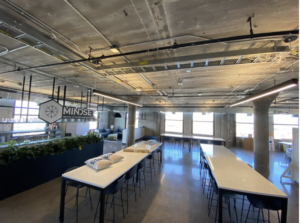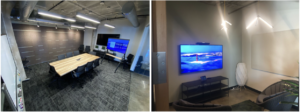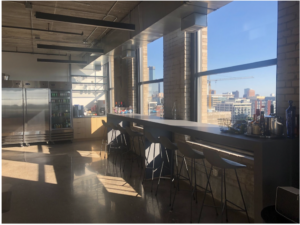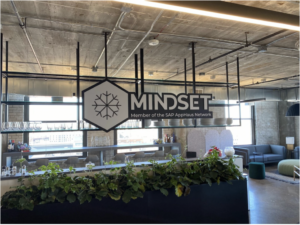At the end of last year, I had the opportunity to lead a hybrid design thinking engagement at the Mindset AppHaus with a multibillion-dollar company that involved creating a more seamless experience for their customer master data systems that would reduce the number of incoming credit requests. I wanted to share a little bit about this insightful experience.
What is a Design Thinking Workshop?
Design Thinking is an iterative and collaborative process rooted in human-centered design. The first phase involves Discovery – to understand users, challenge assumptions and redefine existing problems. The next step involves Framing – to ideate methods of solving these redefined problems. Design Thinking workshops allow teams to work through this process in facilitated group activities. At Mindset, we practice Design Thinking in order to find innovative solutions, build empathy with the end user, and ensure they remain the focus throughout development.
Ideally, in-person and hybrid workshops allow for greater connection and alignment, allowing teams to roll their sleeves up and have challenging and insightful discussions to understand problems and opportunities for solutions better. Tactically, the AppHaus provides an excellent environment for this collaboration.
What is an AppHaus?
The SAP AppHaus Network is a community of 23 global locations that leverage the full potential of SAP’s Business Technology Platform (BTP). One of those locations happens to be the Mindset Offices in Minneapolis, Minnesota. It’s a place dedicated to getting people out of their day-to-day office life and into a space that fuels creativity.
What Makes the AppHaus Special?
I still remember the first time walking into the AppHaus and being stunned by how clean and inviting the room was and how open the physical space was for collaboration. It felt warmly familiar, like the open startup environments I used to work in. This isn’t a dull and dreary conference room but an entire space designed for innovation.

(A space made for design thinking)
The main area can hold at least 50 people with plenty of room to spare. It’s modular, too, with space for meetings or activities, regardless of size and shape. This was all a wonderful sight to see as a designer, and I knew this was where I could make magic happen.
To quote a member of our client’s team:
“It’s a very collaborative space. It has a lot of functionality in different ways. Different seating areas and ways to collaborate are at your fingertips, like whiteboards you could roll in. I liked the other spaces where we could follow up in smaller groups and have different conversations in a casual space easily accessible and nearby; it was very inviting.”

(Some of the breakout rooms available are spacious, while others are more intimate)
While the Mindset AppHaus space is just the tip of the iceberg for a fun and inviting experience, the people and process are the other ingredients for an insightful and successful Design Thinking workshop.
What Does a Successful Design Thinking Workshop Look Like?
When clients spend time in the AppHaus, we ensure they are guided throughout the day and that we are fostering an open collaboration environment. This includes setting up Zoom smart displays for screen sharing, whiteboards, omnidirectional conference microphones, and speakers for our remote participants.
Each step of the day is catered to what our clients need. This even includes snacks and coffee in the morning while attendees are arriving. We take this time to connect with our clients and build rapport before the day begins, not to mention giving some of the late risers a chance to get energized. Each activity ensures we maximize the breadth and depth of ideation and solutioning.
Since we meet clients where they are, as I was planning the agenda for this workshop, it was essential that we spent time as a team to gain alignment on the insight received from the client’s research team. During the Discovery phase, we created a stakeholder map to ensure everyone understands the roles and responsibilities of the core team and stakeholders. We discussed business, product, and engagement goals to align ourselves on what we hoped to accomplish throughout this engagement and what problems might get in the way of achieving success. These business-driven outcomes keep us grounded and focused throughout the engagement.
After a short break, we went into validating our user personas. This activity ensured we would design with the right end user in mind. Our last item on the agenda for the morning was reviewing our first pass at a Lean Hypothesis. This allows us to connect the problem we’re trying to solve to the product we will design later.
How Innovation is Enhanced in the AppHaus
Sometimes the Discovery process can take longer than expected, or new insights may come to light. I think it’s important to flow with the needs of the discussion and find that critical information before moving on to the Framing phase of Design Thinking. Lunch can be one of the more essential parts of a design thinking workshop to keep the momentum going and ultimately find solutions. A big perk of attending a workshop at the AppHaus is catered lunch for everyone. I still remember the delicious Greek food we had catered.
Lunch is placed off to the side to provide guests with some room to breathe, move around, and converse privately. Lunch allows us to connect with our stakeholders and debrief on the morning insights. During the workshop, lunch gave the team time to review the morning results and make the requisite changes to the afternoon schedule.

(A great place to connect)
For example, spending additional time re-addressing our personas and their user flows would be beneficial. Thanks to the AppHaus having multiple whiteboards to write on, I could plan and facilitate a group activity that let our client take the lead and use them to chart the existing user flows for us to gain additional understanding. During this activity, another team member copied the flow into a chart and used the smart screens to cast it for everyone to refer to. Everyone could see and freely approach the whiteboards for maximum collaboration.
We also spent time in a group Design Studio creating low-fidelity mockups using markers and paper. Design Studios are great because they bring together a group of diverse team members to share their vision of how the product can look. It unifies teams in an agreed-upon direction to take the project. We could use the whiteboards to hang up sketches and stand in a semicircle around the whiteboards to discuss.
Our most recent client found it to be a very productive activity:
“Doing a design studio at AppHaus allowed me to directly see what the team envisioned and what the solution would look like. It helped me to understand who was following, who wasn’t, and to see different perspectives I would not have thought of.”
After reviewing our progress, we have a happy hour and offer AppHaus guests to join us for a celebratory dinner. We love being able to talk casually and connect with our clients. Plus, it’s more fun to work closely with people we feel more connected to.

Within Mindset’s AppHaus collaborative space, the people involved, and the value of the design thinking process, clients leave with clarity and alignment of the problem, findings from user insights, narrowed scope and possible solutions from collaborative ideation and prioritization. These deliverables shape the next steps of possible prototypes, test assumptions, and become a source of truth. They become a source of truth we can consistently reference when designing.
The Mindset AppHaus provides a highly collaborative space that allows us to connect with our clients, their problems, and possible solutions in a way that leaves the team eager to see ideas come to life in development. The AppHaus, the people, and our tried and true process helped make the Design Thinking Workshop a successful and enriching experience.